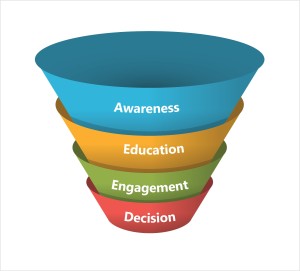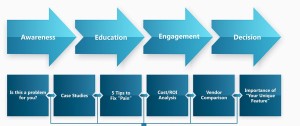There’s a lot out there about the Buyer Engagement Cycle or the Buying Cycle. For B2B sales teams, it’s important to break the process down into finer detail than most marketing folks typically do.
The common Buying Cycle goes like this:
Awareness, Interest, Consideration/Trial, Purchase, Support, Loyalty, Advocacy
A crucial aspect of this cycle is of course, the “after the sale” components. B2B organizations must ensure someone is focused on leading customers all the way through to advocacy.
However, in the inbound marketing, automated, fractured attention world that B2B salespeople deal with today, there is importan t nuance in the first few steps.
t nuance in the first few steps.
The phases the B2B sales team is typically responsible for are:
-
- Awareness
-
- Education
-
- Engagement
-
- Comparison
- Decision
Awareness is not the customer becoming aware of the brand but, the customer becoming aware of a problem, challenge or opportunity.
A customer may know about your company but, they may not know that you have a better way of doing things today than they are doing them now. This is where the concept of “Pain”, common in many sales training programs, is helpful.
You might be very happy with your shoes. But, all of the sudden, when you put your feet up and a friend points out that you have a hole wearing in the sole, now you can’t stop thinking about it. You’ve become aware!
In business scenarios, the customer may notice a problem in their operation but, often, they are blissfully unaware of any problems until along comes the B2B salesperson, who points out how inefficient their current setup is.
Whether it’s the customer who initiates the process, your marketing or your sales team, the mistake too many businesses make is to jump immediately into a typical sales process.
It’s helpful to imagine someone stepping on the scale for the first time in several months and realizing they’ve put on considerable weight. They’re going to be surprised, maybe shocked, maybe confused (How did that happen?!)… But, most of us don’t immediately start calling gyms to shop for memberships.
We may even go into a denial phase and be offended when a salesperson tries to solve a problem we can’t yet admit we have!
If our goal is to build long lasting relationships of trust with the customer, then rather than trying to drag them forward toward our goals, it’s best to earn their trust with patience and appropriate information or help.
Marketing and sales departments are both guilty of this “rush” to close. An ad may stir the thought in the customer that a change is warranted but, a landing page offering 20% off to sign up now is not likely to work.
Having just made a customer “aware” of a need or problem, a salesperson should ask questions and validate this new information:
“How does that feel?” “How is that hurting your processes?” “Is your team aware of this?” “This must be surprising…” “You’re not alone… Can I tell you about a customer that came to the same realization recently?”
And marketing can accomplish the same thing by offering content: “5 Ways XXX is costing you money”, “Are you at risk due to XXX?”
Then carefully test the water to determine when the customer is ready to consider making a change:
The salesperson asks: “If you’d like, I could share with you some simple tips for improving the situation before you make any serious changes.”
Marketing offers: “3 Simple Ways to Improve XXX”
When the customer is interested in learning about improving the solution, the door has begun to open. However, it’s important to proceed cautiously. You’ve awakened the previously unaware and motivated them to act but, your competitors are only a Google search away. If you’re approach is too pushy or just jumps too far forward in the process before they’re ready, you’ll lose their attention.
The salesperson is best served by asking for permission: “When you’re ready, I can share with you some options for making a significant improvement.” Marketing offers content: “3 Ways to Reduce Failures by 25% or more”.
Most B2B marketers are doing good to create a educational, content based campaigns. Due to the complexities of managing campaigns, normally the campaign ends up with a few content pieces and then every third or fourth email asks for something like a purchase. With this approach, customers who have done nothing to indicate they’re interested are being asked to take action, make a purchase, etc. Someone who may have read an article on your blog that opened their eyes to a potential problem is being told they need to fix it now. They’re not ready for that. Don’t go from Awareness to Decision. Just help them go from Awareness to Education and then when they’re ready, take them to the next step.
campaign ends up with a few content pieces and then every third or fourth email asks for something like a purchase. With this approach, customers who have done nothing to indicate they’re interested are being asked to take action, make a purchase, etc. Someone who may have read an article on your blog that opened their eyes to a potential problem is being told they need to fix it now. They’re not ready for that. Don’t go from Awareness to Decision. Just help them go from Awareness to Education and then when they’re ready, take them to the next step.
Break down the buying cycle for your customers and create campaigns that take things one step at a time. Here are some tips on the tone to take:
-
- Awareness – keep offering more content that deepens and broadens awareness and ask, “Would you like to learn about possible solutions?”
-
- Education – keep showing me how solving the problems has improved life. And, offer calls to action like “Have questions?”, or even better, ask the questions you want to hear customers that are learning about options asking! “How do I fix….”
-
- Engagement – break down the buying questions and create content that asks them and then answers.
-
- Comparison – this one’s easier… side by side comparisons of your features with your competitors, your different packages with each other and in depth cost analysis compared with competitors and your other options.
- Decision – create urgency. What’s the cost of delaying, waiting, maintaining old equipment, etc.
Can you put a “Sign up now” buttons in your emails or on your landing pages? Yes! Just don’t make that the whole point of the email or ad! Focus on content that’s appropriate for the buyer at the stage they are currently in and if they’re ready to buy, they’ll let you know.
